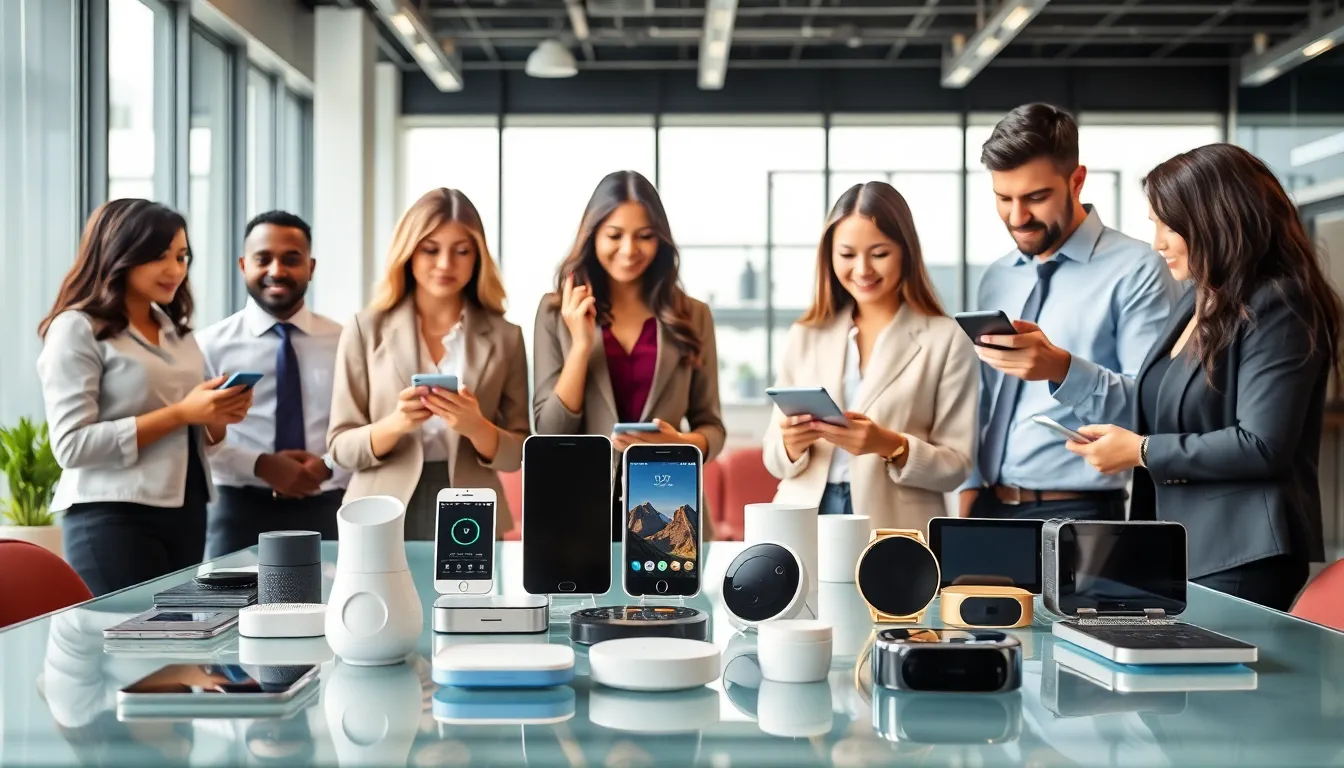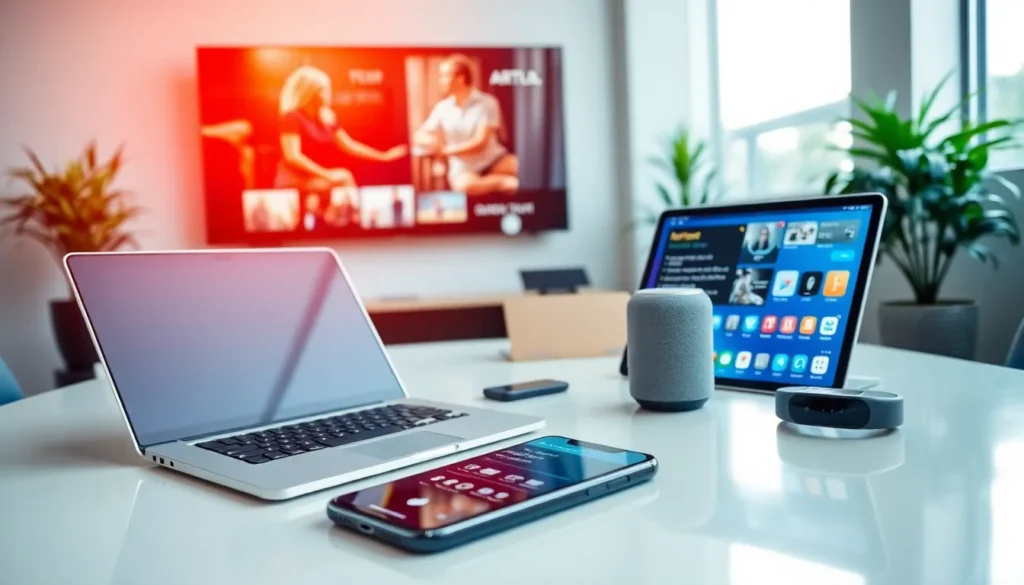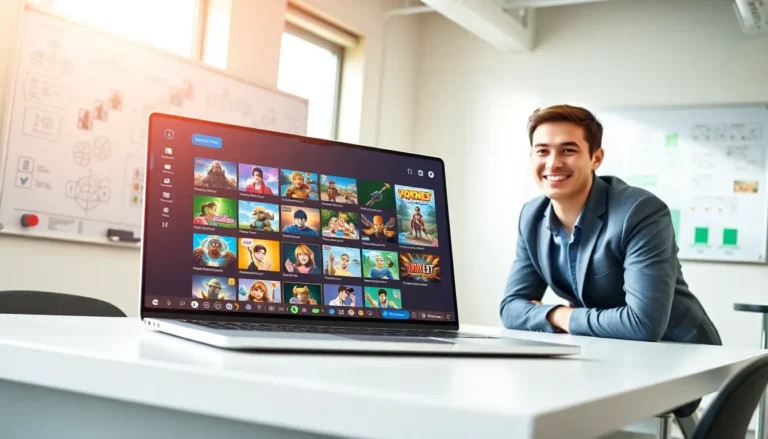Table of Contents
ToggleIn today’s fast-paced world, technology devices act as the lifeblood of our daily activities. From communication to entertainment, these gadgets shape the way we connect, learn, and unwind. While we might feel overwhelmed by all the options out there, fear not. In this journey through various types of technology devices, we’ll break everything down into bite-sized sections that are as easy to digest as your favorite snack, without any of the calories. Let’s jump into this digital playground, exploring everything from that trusty smartphone to futuristic devices we can only dream about.
I. Overview Of Technology Devices

Technology devices come in all shapes and sizes, catering to the diverse needs of users around the globe. This list includes devices specifically designed for communication, entertainment, home automation, wearables, and computing. As we progress, each category will reveal unique attributes and functionalities, reflecting the ingenuity behind today’s tech landscape.
Technology has seamlessly integrated into our lives, attracting users of all ages. With innovations driving evolution in design and usability, even traditional devices continuously adapt to meet demands. Understanding various types of technology devices not only demystifies their potential but also helps individuals make informed choices to enhance their lives.
II. Communication Devices
Communication is at the heart of human interaction, and technology devices play a crucial role in facilitating these connections.
A. Smartphones
Smartphones have revolutionized how we communicate. These pocket-sized wonders combine cellular technology with internet access, allowing users to engage through calls, texts, emails, and social media. They often come equipped with high-quality cameras for capturing memories. With various operating systems like iOS and Android, smartphones cater to different user preferences and lifestyles.
B. Tablets
Sitting somewhere between smartphones and laptops, tablets offer a versatile experience. Users enjoy larger screens that enhance reading and viewing experiences, whether browsing the web or watching videos. They can run various applications and connect to keyboards, making them ideal for both leisure and productivity tasks. Popular options include Apple’s iPad and Android-based devices.
C. Laptops and Desktops
While smartphones and tablets are powerful communication tools, nothing compares to the functionality of laptops and desktops. These devices are equipped with full-sized keyboards and larger displays, perfect for extensive writing, gaming, and graphic design. They serve as central hubs for productivity, whether at home or in the office. The choice between laptops and desktops often boils down to portability versus performance.
III. Entertainment Devices
When it comes to unwinding after a long day, entertainment devices are essential.
A. Smart TVs
Smart TVs have transformed how users consume content, integrating internet capabilities that allow streaming services like Netflix and Hulu. These devices not only display high-definition images but also support apps that connect users to their favorite shows, movies, and games seamlessly. With voice control and compatibility with smart home systems, they enhance the viewing experience beyond mere entertainment.
B. Gaming Consoles
Gaming consoles such as the PlayStation, Xbox, and Nintendo Switch provide immersive experiences, allowing players to jump into virtual worlds. With powerful graphics, multiplayer functionalities, and exclusive titles, these devices bring friends and family together. They cater to casual and hardcore gamers alike, continually evolving through software updates and new hardware releases.
C. Streaming Devices
Streaming devices, including Roku and Amazon Fire Stick, simplify access to various streaming platforms. Users can bypass conventional cable subscriptions and curate their own viewing experiences, adapting to personal preferences. These compact devices connect to TVs via HDMI and often provide voice control, making them convenient, user-friendly additions to any entertainment setup.
IV. Home Automation Devices
The rise of smart technology has led to an increase in home automation devices, making life at home more convenient.
A. Smart Speakers
Smart speakers like Amazon Echo and Google Nest allow users to control their smart homes through voice commands. These devices can play music, provide weather updates, and manage other smart devices within the home. Integration with virtual assistants adds an extra layer of convenience, creating a seamless environment for users.
B. Smart Thermostats
Smart thermostats enable users to control their home’s heating and cooling systems from anywhere using their smartphones. Devices like the Nest Learning Thermostat learn individual schedules and preferences to optimize energy usage, contributing to both comfort and savings on utility bills.
C. Security Cameras
Home security cameras play a vital role in safeguarding properties. Offering features like real-time monitoring and motion detection, these devices ensure peace of mind for homeowners. Many models now integrate with smartphone apps, allowing users to keep an eye on their homes from any location, enhancing overall safety.
V. Wearable Technology
Wearable technology has gained significant traction over the last few years, appealing to health-conscious individuals.
A. Smartwatches
Smartwatches, like the Apple Watch and Samsung Galaxy Watch, provide notifications, fitness tracking, and health monitoring all from the wrist. These devices have evolved into essential tools, offering features like heart rate monitoring, GPS navigation, and communication capabilities, making them popular choices for tech-savvy users seeking convenience on the go.
B. Fitness Trackers
Fitness trackers, such as Fitbits, help users monitor their physical activity and overall health. Many come equipped with features to track steps, sleep patterns, and heart rates. They encourage an active lifestyle by providing reminders and goal-setting capabilities, thereby fostering healthier habits.
VI. Computing Devices
The realm of computing devices is vast and ever-evolving, accommodating various user needs.
A. Tablets vs. Laptops
The debate between tablets and laptops continues, with each offering unique advantages. Laptops are often preferred for heavy-duty tasks like video editing and gaming, while tablets shine when it comes to portability and casual browsing. The choice eventually depends on specific user requirements and preferences, some may even opt for a hybrid or 2-in-1 device for the best of both worlds.
B. Cloud Computing Devices
Cloud computing devices help access to files and resources from anywhere with an internet connection. By storing data in the cloud, users can free up local storage on their devices. These tools make collaboration easy, helping teams work together seamlessly, improving productivity and efficiency.
VII. Future Trends In Technology Devices
As technology continues to evolve, several trends are emerging in device development:
- Artificial Intelligence Integration: Expect smarter devices capable of learning and adapting to user behaviors.
- Augmented Reality (AR): Devices with AR capabilities will enhance experiences in areas like gaming, education, and shopping.
- Sustainability Initiatives: More companies are focusing on eco-friendly materials and practices in device production.
- Wearable Health Tech Advancements: Innovations in health monitoring wearables promise advancements in fitness and wellness management, from glucose monitors to sleep aids.
The future of technology devices looks promising, with advancements optimized for user experience and functionality.





